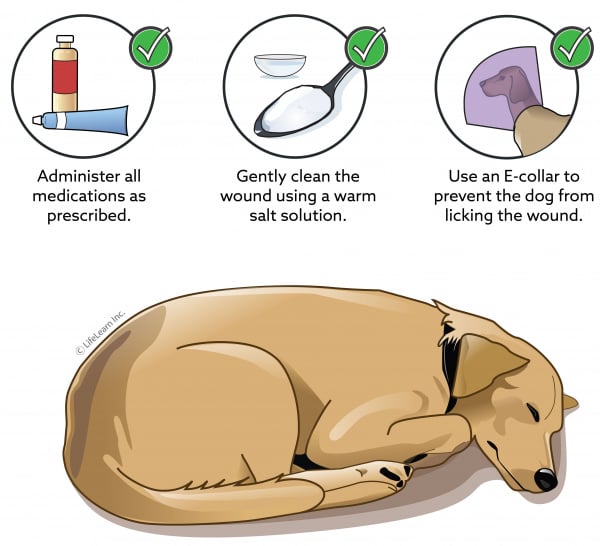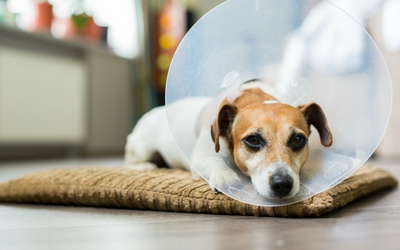what to do for a cut on my dogs leg
My dog has a large open wound and my veterinarian recommended leaving it open to heal rather than repairing it with sutures. Why is this?
Wounds vary according to:
Cause - puncture wounds, abrasions, or lacerations
Location - paws, abdomen, eyes, etc.
Level of contagion - make clean (surgical) wounds, contaminated (infected)
Your veterinarian has considered all of these factors when deciding the best way to treat a specific wound. Sometimes the location or the amount of skin loss prevents surgical closure or bandaging (wounds on the face or loftier up on the leg).
Sometimes, puncture wounds or other trauma forcefulness bacteria deep into the tissues. A contaminated wound that is more than a few hours old should never be airtight without surgical debridement (removal of all the contaminated or dead tissue), and in some cases this may consequence in more than permanent damage than treating the wound medically and leaving it open up to heal.
What volition be done for my dog'due south wound?
Abscesses may be lanced and cleaned nether heavy sedation or anesthesia. A latex drain will exist placed to forestall the wound from endmost too quickly in order to allow proper drainage and prevent the further build-upwardly of infection.
"Wherever possible a wound will be closed and sutured in order to speed healing."
Wherever possible, a wound volition exist closed and sutured in order to speed healing. However, if in that location is gross contamination or deep infection nowadays, the wound volition exist left open for topical treatment and to ensure drainage.
Your veterinarian may need to hypnotize your dog to remove strange textile and dead tissue from the wound. If the wound cannot be surgically closed, your veterinarian may apply a protective cast if this is possible. Your dog will receive oral or injectable antibiotics (such every bit amoxicillin-clavulanate or cefazolin).
How volition I need to treat this open wound? 
When your pet was discharged from the hospital, you received specific instructions regarding your pet's habitation care. Some general care guidelines include:
- It is important that the wound and surrounding area is gently cleaned to remove whatsoever crusty or sticky debris. This will keep the wound edges clean, reduce the potential for re-infection, and allow new healthy tissue to develop.
- Administer all of the medications as prescribed. Do not discontinue antibiotics for any reason unless you have been specifically instructed to practise then by your veterinarian.
- Your dog should not exist immune to lick or chew the open wound. Many dogs volition crave a protective collar (run into handout "Elizabethan Collars in Dogs" for more information) to prevent them from injuring the site.
- It is important to forbid the skin from healing over the wound too apace. This is particularly important with abscesses that have been lanced and tuckered surgically. If the wound closes prematurely, the risk of recurrence increases.
How exercise I prevent the wound from closing also early?
When cleaning the wound, gently massage the surrounding skin to open the wound and promote drainage. Y'all may note some discharge or haemorrhage when y'all practise this. Annotation whether it appears to be infected (a thick or colored belch) or if it is a clear thin fluid. You lot should remove or allow either type of belch to drain abroad. If the discharge continues to be bloody, green, or xanthous for several consecutive days, contact your veterinary for instructions.
What should I make clean the wound with?
Warm tap h2o is recommended for cleaning most wounds. Warm saline (table salt solution) may also be used. This may be fabricated past adding approximately one level teaspoonful (5 mL) of salt (or Epsom salts) to two cups (500 mL) of water. In some cases, your veterinarian may recommend using a dilute cleansing solution of chlorhexidine, a surgical lather, or an iodine solution to assistance remove debris.
"Do Non use soaps, shampoos, rubbing booze, hydrogen peroxide, herbal preparations, tea tree oil, or whatever other production to make clean an open up wound."
Practice Not utilise soaps, shampoos, rubbing alcohol, hydrogen peroxide, herbal preparations, tea tree oil, or any other product to make clean an open wound, unless specifically instructed to exercise and so by your veterinarian. Some of these products are toxic if taken internally, while others can actually delay healing.
Can I not use balmy antiseptics?
Your veterinary may prescribe antibiotics or a suitable antibiotic foam to apply to the wound. Since animals tend to lick and chew at wounds, inadvertently swallowing medications that are applied topically, or disinfectants and antiseptics intended for human use are rarely suitable for use in animals.
What should I do if my dog tries to lick the wound? 
Many people have the mistaken belief that domestic dog's saliva is somehow antiseptic. This is far from the truth, especially when one considers how dogs groom themselves or greet each other. A dog will instinctively lick at a wound, but this can seriously delay healing. Therefore, you must foreclose this past any means possible. Elizabethan collars are the most commonly used protective device. Other options, depending on the location of the wound, include covering the wound with a bandage, a stockinette, a canis familiaris coat, or a t-shirt.
What about hurting medications?
Your veterinarian will prescribe appropriate medications to relieve pain and discomfort. Once a wound has begun to heal, information technology is no longer as painful. Your veterinarian will assess the individual situation and determine the most appropriate medications for your dog. Pain medications well-nigh typically prescribed are not-steroidal anti-inflammatory drugs (NSAIDs) such as meloxicam (Rheumocam, Metacam®), deracoxib (Deramaxx®), or carprofen (Rimadyl®).
greercommayfuland.blogspot.com
Source: https://vcacanada.com/know-your-pet/care-of-open-wounds-in-dogs
Post a Comment for "what to do for a cut on my dogs leg"